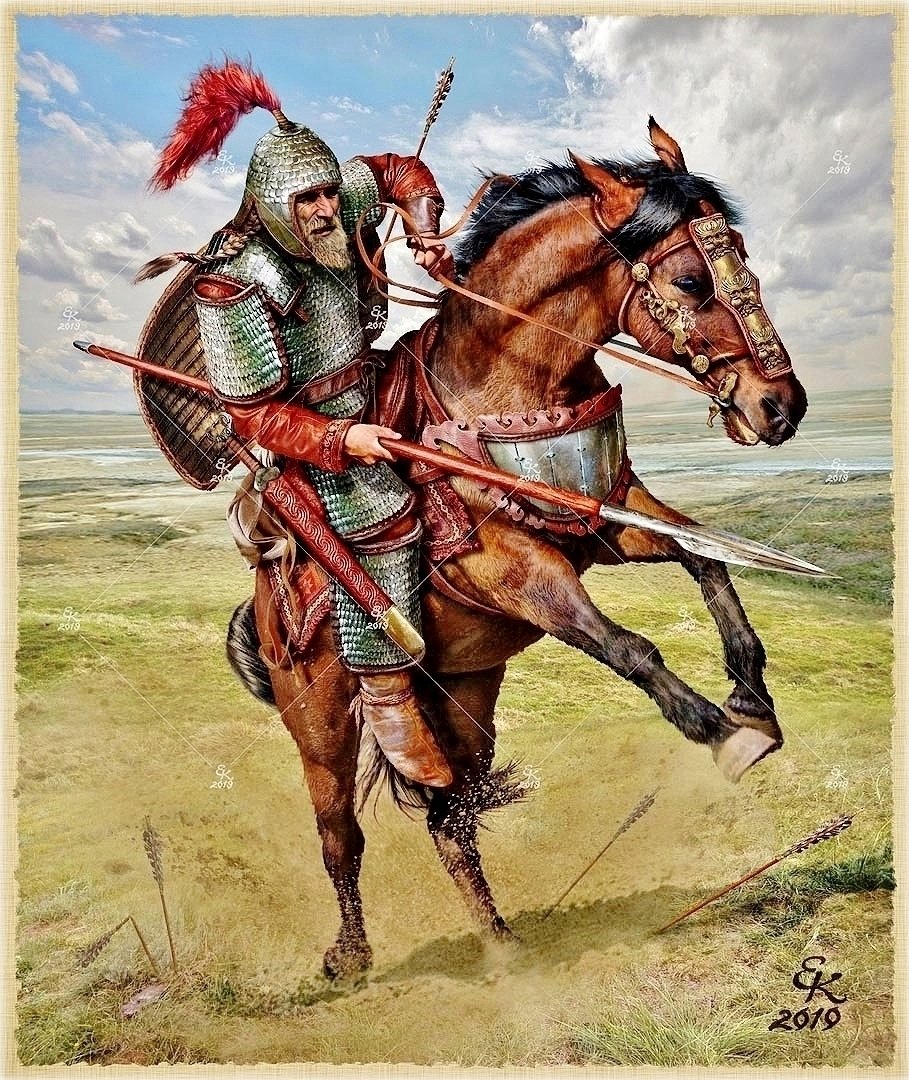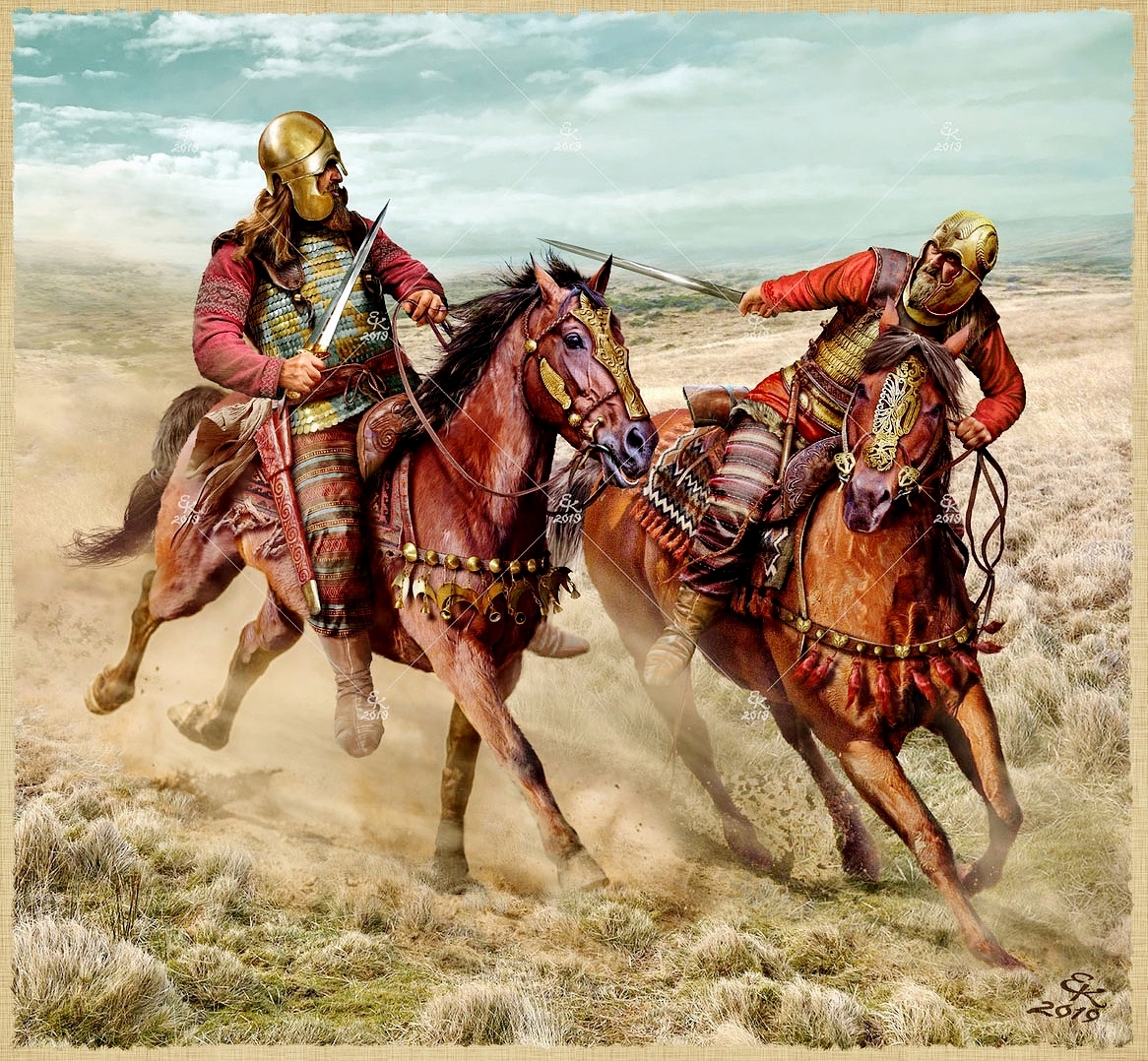Ancient Scythian; Scytho-Siberian (Aldy-Bel; Kamensk and Pazyryk cultures); Sarmatian; Cimmerian; Maeotian and Sakā tigraxaudā Warriors.
Art by Evgeny Kray.
All credit goes to the artist.
Scythian, Kelermesskoye kurgan, Adygea, VIIth C. BC
Pazyryk Scythian, Altai, IVth C. BC

Art by Evgeny Kray.
All credit goes to the artist.
Scythian, Kelermesskoye kurgan, Adygea, VIIth C. BC
Pazyryk Scythian, Altai, IVth C. BC

Scythian woman warrior, Pazyryk culture. Altai, IVth C. BC
Scythian noble, Southern Siberia VII - VI C. BC (based on materials from the excavations of the burial grounds of Gilyovo-10, Loktevsky District, Altai Krai and Kichigino-1, the South Urals, Chelyabinsk Oblast, Russia)
Scythian noble, Southern Siberia VII - VI C. BC (based on materials from the excavations of the burial grounds of Gilyovo-10, Loktevsky District, Altai Krai and Kichigino-1, the South Urals, Chelyabinsk Oblast, Russia)
A Scythian noble from the entourage of the king, Aldy-Bel culture, dated to the 7th to 3rd C.C. BC, named after the site of the Aldy-Bel I kurgan in Tuva Republic, southern Siberia, Russia
Early Scythian warrior, VIth C. BC from the Altai mountains region of Kazakhstan
Early Scythian warrior, VIth C. BC from the Altai mountains region of Kazakhstan
Early Scythian warrior, Arzhan-2 kurgan in the Tuva Republic, Russia, dated to the VII C. BC
Old honored Scythian elder of the Pazyryk culture, Altai, V - IV C. BC
Old honored Scythian elder of the Pazyryk culture, Altai, V - IV C. BC
Scythians, most likely of the Paralatae (Royal Scythians) (mounted and dismounted, on the left) battle a dismounted Maeotian, in the service of the Bosporan Kingdom (on the right), IVth C. BC
Wounded Scythian archer, of the Scythian nomads, Northern Pontic littoral, IVth C. BC
Wounded Scythian archer, of the Scythian nomads, Northern Pontic littoral, IVth C. BC
Heavy armed Scythian warrior of the Paralatae (Royal Scythians), Northern Pontic littoral, VII-VI C.C. BC
Scythian king (right) of the Paralatae (Royal Scythians) and his warlord (left), Northern Pontic littoral, Vth-IVth C.C. BC
Scythian king (right) of the Paralatae (Royal Scythians) and his warlord (left), Northern Pontic littoral, Vth-IVth C.C. BC
Scythian warrior of the Paralatae (Royal Scythians), nocks his bowstring, Northern Pontic littoral, Vth C. BC
A Scythian warrior's send-off to his campaign, Paralatae (Royal Scythians), Northern Pontic littoral, VIth - Vth C. BC
A Scythian warrior's send-off to his campaign, Paralatae (Royal Scythians), Northern Pontic littoral, VIth - Vth C. BC
A wounded, heavy armed Scythian warrior continues his attack, Paralatae (Royal Scythians), steppes of the Northern Pontic littoral, Vth C. BC
Scytho-Maeotian king, based on finds in kurgans near Stanitsa Yelisavetinskaya, on the Kuban river, Krasnodar Krai, Russia, Vth-IVth C BC
Scytho-Maeotian king, based on finds in kurgans near Stanitsa Yelisavetinskaya, on the Kuban river, Krasnodar Krai, Russia, Vth-IVth C BC
Sarmatian warrior, IIIrd - IInd C.C. BC, Kuban river region, Krasnodar Krai, Russia
Sarmatian warrior, IInd - Ist C.C. BC, steppes of the Northern Pontic littoral
Sarmatian warrior, IInd - Ist C.C. BC, steppes of the Northern Pontic littoral
Sarmatian warrior, Vth - IVth C.C. BC, based on finds in Filippovka-I burial ground, on the plains of the Uralo-Ileksky drainage divide, southern end of the Ural Mountains, Orenburg Oblast, Russia
Sakā tigraxaudā warrior from the southern end of the Ural Mountains, VIth C. BC
Sakā tigraxaudā warrior from the southern end of the Ural Mountains, VIth C. BC
Scythian ''Amazon'' warrior woman, VIth C. BC, in the thick of a battle with, probably, the Sarmatians, Northern Pontic littoral
Scythian warrior of the Northern Pontic littoral, in battle, Vth C. BC
Scythian warrior of the Northern Pontic littoral, in battle, Vth C. BC
Maeotian warrior from the Kuban river region, IIIrd - IInd C. BC
Cimmerians during the invasion campaign into the Kingdoms of Phrygia, Colchis, Urartu, subject to the Neo-Assyrian Empire, and Neo-Assyrian Empire itself. North Caucasus, VIIIth - VIIth C. BC
Cimmerians during the invasion campaign into the Kingdoms of Phrygia, Colchis, Urartu, subject to the Neo-Assyrian Empire, and Neo-Assyrian Empire itself. North Caucasus, VIIIth - VIIth C. BC
Scythian noble/chieftain of the Pazyryk culture, Altai, Vth C. BC
Scythians of the Kamensk culture, Southern Siberia, Altai, herding sheep, Vth - IVth C. BC
Scythians of the Kamensk culture, Southern Siberia, Altai, herding sheep, Vth - IVth C. BC
A skirmish between a Cimmerian (up) and a Scythian (below), in the Northern Caucasus, VIIth C. BC
A skirmish between a Maeotian (left) and a Scythian (right), in the Northern Pontic littoral, IVth C. BC
A skirmish between a Maeotian (left) and a Scythian (right), in the Northern Pontic littoral, IVth C. BC
Sarmatian mercenary, in the service of the Bosporan Kingdom, and a wounded Scythian, Eastern Crimea, IIIrd C. BC
Scythian ''Amazon'' warrior woman of the mythical Halizones tribe, Northern Pontic littoral, IVth C. BC
Scythian ''Amazon'' warrior woman of the mythical Halizones tribe, Northern Pontic littoral, IVth C. BC
Scythian warrior from the steppes of the Northern Pontic littoral, IVth C. BC
Illustration to the "Early Sarmatian Knight'' article, by Soviet and Russian archaeologist L.T. Yablonsky. Early Sarmatian period, known as the Prokhorovka culture, lasted from the IVth to IInd C.C. BC
Illustration to the "Early Sarmatian Knight'' article, by Soviet and Russian archaeologist L.T. Yablonsky. Early Sarmatian period, known as the Prokhorovka culture, lasted from the IVth to IInd C.C. BC
Portrait of the Pazyryk Scythian chieftain, in a headdress, from the Pazyryk Barrows, Altai, Vth-IVth C. BC
Portrait of the Kamensk culture Scythian chieftain, in a headdress, based on finds in Lokot-4a burial ground, Lokot village, right bank of the Aley river, Altai, IV C. BC
Portrait of the Kamensk culture Scythian chieftain, in a headdress, based on finds in Lokot-4a burial ground, Lokot village, right bank of the Aley river, Altai, IV C. BC
In conclusion
Grave goods of a Scythian warrior king, creation of a kurgan and a quote from the Lament for the Rohirrim in Russian:
'Где ныне конь боевой,
Где звонкого рога пение?
Отгремели горной грозою,
Отшумели степными ветрами,
Сгинули дни былые,
В закатной тени за курганами'
Grave goods of a Scythian warrior king, creation of a kurgan and a quote from the Lament for the Rohirrim in Russian:
'Где ныне конь боевой,
Где звонкого рога пение?
Отгремели горной грозою,
Отшумели степными ветрами,
Сгинули дни былые,
В закатной тени за курганами'

 Read on Twitter
Read on Twitter






































